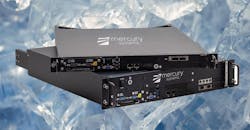Electronic systems for aircraft applications must be built for long lifetimes and high reliability, and usually simpler is better. In the case of a line of rack-mount computer servers for airborne applications from Mercury Systems, high performance is possible without a fan. A special power supply helps to provide the processing power needed for airborne systems operating at high altitudes. The EnterpriseSeries RES Aero rack-mount servers achieve higher reliability and longer mean time before failure (MTBF) without the fan, and without compromising performance.
The noise-free RES Aero servers are certified to NAVAIR MIL-STD 461 for EMI and multiple military specifications and are available with additional certification. They feature patented memory stabilization technology to prevent disconnections and downtime as a result of high shock and vibration airborne environments. The small (20 in. deep) form factor and light weight (less than 20 lb.) belie the performance of computer servers powered by dual Intel Xeon processors. The servers are equipped with front-panel I/O and LED indicators to simplify maintenance and include many expansion slots for adding functionality. A custom power supply can handle a wide range of voltage requirements, including the 270 V dc found on aircraft.
“Legacy airborne processing systems are expensive, difficult to upgrade, and quickly outdated by newer technologies,” said Scott Orton, vice president and general manager of Mercury’s Trusted Mission Solutions group. “By working closely with customers to assess their demanding airborne computing needs, we purpose built our RES Aero product line as a cost-effective and flexible solution that delivers high-performance processing, while eliminating the added risk of moving mechanical parts.”
About the Author
Jack Browne
Technical Contributor
Jack Browne, Technical Contributor, has worked in technical publishing for over 30 years. He managed the content and production of three technical journals while at the American Institute of Physics, including Medical Physics and the Journal of Vacuum Science & Technology. He has been a Publisher and Editor for Penton Media, started the firm’s Wireless Symposium & Exhibition trade show in 1993, and currently serves as Technical Contributor for that company's Microwaves & RF magazine. Browne, who holds a BS in Mathematics from City College of New York and BA degrees in English and Philosophy from Fordham University, is a member of the IEEE.

